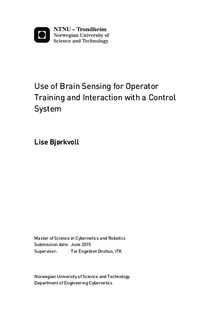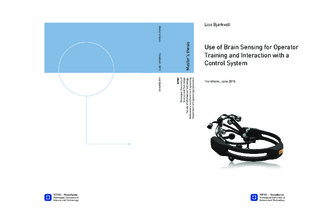| dc.description.abstract | The aim of this project has been to evaluate the possibility of identifying an operator's mental state from electroencephalography (EEG) signals in a control room setting using a low cost neuroheadset. This has been done through the development of a brain sensing application. To carry out the project, the neuroheadset Epoc from Emotive has been utilized. Epoc has 14 sensors, and the EEG signals measured by the neuroheadset are acquired via a wireless connection. A thorough study on brain sensing technology, in conjunction with extensive research in identifying mental states from EEG signals has been crucial. After designing a number of possible use cases, it was decided to focus on an overall goal of improving work conditions for operators. This can be achieved either through utilization of the application in operator training or in developing improved control room systems and better user interfaces. The brain sensing application was designed and implemented based on using raw EEG data and identifying mental states through a spectral analysis. The application provides the option of either processing a data set for analysis, or in real time for use in a concept demonstrator. The application has been tested and shown to work well through initial measurements from test subjects, as well as through a concept demonstrator based on the use cases that were developed, by integrating the application in a control room simulator.
A study within the field of neuroscience, neurophysiology and brain sensing technology showed that in the state of the art, researchers are currently working to identify mental states from EEG signals. So far, they lack a simple, accepted methodology for identifying any of the desired mental states for this project; workload, fatigue and mental stress. Seeing as no methodology was ready for implementation, it was decided to utilize the developed brain sensing application to investigate if prior research explaining how to identify workload from EEG signals was valid. A study with ten participants performing an IQ-test was conducted, and the participants EEG signals were analyzed. The NASA-TLX assessment form was used to obtain subjective workload for the study. The results of the study showed that power in the parietal lobe decreases significantly under increasing workload for signals within the alpha-, beta- and theta- frequency bands. According to previous research, all indications should mainly be seen in frontal lobe. Alpha power should decrease under increasing working memory load, concentration and hard thinking, whereas theta power should increase. A recent paper points to alpha power as the main indication of variation in workload, but despite identifying a trend of decreasing alpha power, too few of the results are significant and the test group is too small to confirm any methodology.
The potential of low cost brain sensing technology for use in a control room setting has been evaluated in this project. A significant portion of the project has been a theoretical study as well as a technology review. This, in addition to obtained results, experiences working with the Epoc neuro-headset, and the development of a brain sensing application have provided the basis for such an evaluation.The evaluation has shown that the neuroheadset can be utilized for operator training, or development of user interfaces and control room systems. In an operative control room setting, the technology must be further developed before it can be used, as the unit is uncomfortable to wear over an extended period of time. The brain sensing application has been proven to work well through testing, and the project shows that it is feasible to integrate a brain sensing application in a control room setting, and thus interact with a control system. Research on identifying mental states from EEG signals is the constraining factor, and once research within this field has progressed, the developed brain sensing application can be updated, and a use case fully implemented. This will provide a concept demonstrator ready for further testing. | |

